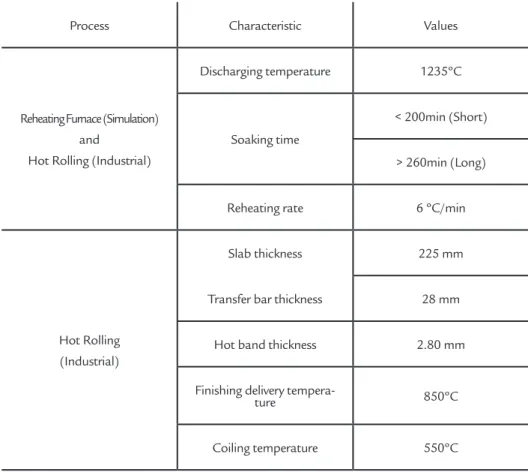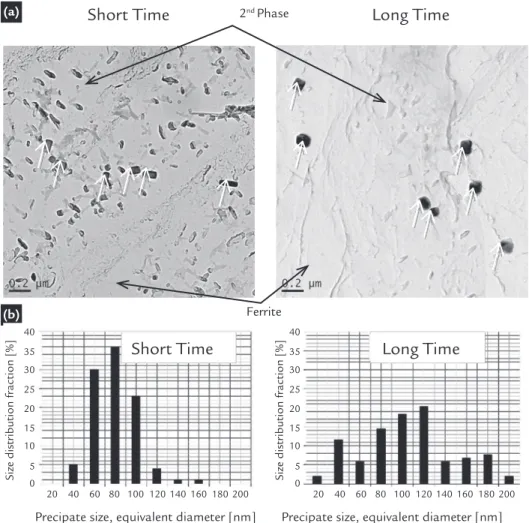435
Metallurgy and materials
Metalurgia e materiais
Deformation induced
precipitation in an industrial
Ti microalloyed dual phase steel
James Albert dos Santos Soares Mohallem
Engenheiro Metalúrgico, M.Sc.
Desenvolvimento de Produtos / ArcelorMittal Tubarão Serra – Espírito Santo – Brasil
james.mohallem@arcelormittal.com.br
João Batista Ribeiro Martins
Engenheiro Metalúrgico, M.Sc.
Desenvolvimento de Produtos / ArcelorMittal Tubarão Serra – Espírito Santo - Brasil
joaobatista.martins@arcelormittal.com.br
Charles de Abreu Martins
Engenheiro Metalúrgico, D.Sc.
Desenvolvimento de Produtos / ArcelorMittal Tubarão Serra – Espírito Santo - Brasil
charles.martins@arcelormittal.com.br
Marcelo Lucas Pereira Machado
Engenheiro Metalúrgico, D.Sc.
Instituto Federal do Espirito Santo / PROPEMM Vitória – Espírito Santo – Brasil
marcelolucas@ifes.edu.br
Abstract
This study evaluated the inluence of plastic deformation during hot strip rolling in the size of TiN precipitates in an industrial Ti microalloyed dual phase steel. TiN is usually used for pinning austenitic grain boundaries during recrystallization and its eficiency depends on factors such as size of the precipitates and Ti precipitated frac-tion. During the slab reheating process, there occurs a partial dissolution of TiN pre-cipitates that subsequently reprepre-cipitates during the hot rolling process. However, this reprecipitation preferentially takes place at crystalline defects which act as nucleation sites. These sites increase with the amount of applied plastic deformation, resulting in smaller precipitates, due to the partial dissolution of larger particles or due to reprecipi-tation in the nucleation sites. Results indicate a reduction of about 28 % in the average size of the precipitates for samples extracted from hot bands (with deformation) and, therefore, a signiicant reduction in austenitic grain size, when compared with samples extracted from slabs (with no deformation).
Keywords: Dual-phase steel, precipitation, TiN and deformation.
http://dx.doi.org/10.1590/0370-44672014680140
1. Introduction
Steels are amongst the most important and useful of engineering materials because of their wide range of mechanical properties and low cost (Puskhareva, 2009). In recent years, the technological advances in the automotive industry are focused on reducing weight, a very relevant issue due to the increasing requirements for fuel-eficiency, which are related to energy savings and environmental restriction regulations. In order to provide a steel-based solution that ful-ills the automobile industry’s require-ments, a great effort is being made to develop and apply a new class of steel, the so-called advanced high strength steels (AHSS), which combine good formability with high mechanical strength, to reduce the thickness of different parts of the automotive body
in white (BIW) without performance losses and ensuring passenger safety (Tsipouridis, 2006).
The application of AHSS, exhib-iting both high strength and excellent formability, offers the unique option of combining weight reduction us-ing thinner gauges of sheet material, providing improved passive safety, optimized environmental perfor-mance and manufacturing feasibility at affordable cost. Among of steels classiied as AHSS, however, one in particular has been widely studied for some years and is potentially very attractive for the automobile industry: dual phase steels.
Basically, dual phase (DP) is a class of high strength low alloy steels characterized by a microstructure consisting of martensite and ferrite.
On the basis of the ferrite-martensite microstructure alone, any further increase in strength can only be ob-tained by an increase in the volume fraction of martensite. This, however, might be done at the expenses of duc-tility and elongation. Another way to increase strength of such steels is to add dispersoid-forming elements, such as titanium, to the steel melt which would form small precipitates and hinder dislocation movement in ferrite (Saikaly et al., 2001).
2. Materials and experimental procedure
The chemical composition of industrial microalloyed dual-phase steel studied is shown in Table 1.
Table 1
Chemical composition of industrial micro-alloyed dual-phase steel studied (wt %).
C Mn Si Ti Cr N Others 0.15 1.9 0.23 0.02 0.25 0.005 < 0.01
In order to study the effects of deformation during hot rolling on the precipitation of TiN, the analysis was done either on an industrial sample (with deformation) or on a sample obtained by simulation (no
deforma-tion), both of them extracted from slabs (simulation) or hot bands (industrial) of the same heat at the steel shop. Fur-thermore, two different soaking times in the reheating furnace were adopted. Samples obtained from slabs as casted
were reheated in a box furnace until 1235ºC, following the industrial reheat cycle for the two soaking times, and then brought into water.
The parameters of simulation and industrial process are given in Table 2.
Process Characteristic Values
Reheating Furnace (Simulation) and
Hot Rolling (Industrial)
Discharging temperature 1235ºC
Soaking time
< 200min (Short) > 260min (Long)
Reheating rate 6 ºC/min
Hot Rolling (Industrial)
Slab thickness 225 mm
Transfer bar thickness 28 mm
Hot band thickness 2.80 mm Finishing delivery
tempera-ture 850ºC
Coiling temperature 550ºC
Table 2 Parameters of
simulation and industrial process.
The study of the microstructure was performed on a JEOL Scanning Electron Microscope (SEM) with Nital 2% metallographic etching. Austenite grain size after reheating was obtained using reagent (picric acid-2g, ferric chloride-2g and 100ml of water) and
examined by optical microscopy. Qualitative and quantitative analysis of TiN precipitates were performed using carbon extraction replicas and analyzed under a JEOL Transmission Electron Microscope (TEM) using bright field image. The amount of
Ti present as TiN was obtained by a methodology that consists in ex-tracting the precipitates of a sample through electrochemical dissolution, obtaining the total precipitation by weight difference and analysis of the Ti in TiN precipitates.
3. Results and discussion
The results of qualitative and quantitative analysis of TiN precipitates of the samples extracted from slabs (no deformation) for the two different soak-ing times are shown in Figure 1. Quanti-tative analysis showed that 73% of total Ti (0.02%) were precipitated as TiN.
Samples submitted to the long soaking time showed larger average TiN precipi-tate size, ranging from 69.4 to 104.1nm as well as a large particle size distribu-tion. This occurs due to the occurrence of titanium nitride (TiN) precipitates coarsening through its partial dissolution
437 long time soaking reheating furnace
simulation when compared to short time soaking (igure 2). The variation of the austenitic grain size occurs because TiN is typically used to inhibit austenite
grain coarsening by pinning austenite grain boundaries (Cuddy;Raley, 1983; Gladman, 1999). However, according to Korchynsky (1993) and by calcula-tions performed by several authors, for
this to occur effectively the size of the precipitates must be smaller than 50nm, and the greater the size of the precipitate, the less effective the anchorage growth of austenitic grain.
Figure 1 Carbon extraction replica characterization by TEM (a) and particle size distribution (b) of samples extracted from slabs (with no deformation) for two different soaking times: short (< 200min) and long (> 260min). The TiN precipitates are marked by white arrows.
Figure 2 Austenitic grain size of samples extracted from slabs (no deformation) for two different soaking times: short (< 200min) and long (> 260min).
Figure 3 shows the results of quali-tative and quantiquali-tative analysis of TiN precipitates of the samples extracted from industrial hot bands (with defor-mation) for the two different soaking times. Quantitative analysis showed that 75% of total Ti were precipitated as TiN. Samples submitted to the long soaking time showed larger average TiN precipi-tate size, ranging from 50.2 to 68.3nm, as well as a larger particle size distribution. As previously discussed, it occurs
due to the occurrence of titanium nitride (TiN) precipitates coarsening through its partial dissolution during the soaking in the reheating furnace and subsequent precipitation together with the deforma-tion in austenite. After slab reheating, roughing brings down the slab thickness (225mm) to around 28mm, leading to a deformation induced precipitation and to smaller mean size precipitates. This be-havior can be explained by the generation of crystalline defects during deformation,
even in the dynamic recrystallization re-gion, which act as a driving force to new precipitation.
These defects (dislocations or sub-structure boundaries) act as nucleation sites for further iner precipitates derived from the Ti and N in solid solution, coming from the dissolution of the TiN during the slab reheating process. This phenomenon was also reported by Liu, Jonas (1998) and Saikaly, et al. (2001).
Figure 4 shows the austenitic grain (a)
(b)
Short Time
Long Time
Short Time
Long Time
Precipate size, equivalent diameter [nm] Precipate size, equivalent diameter [nm] Averaged size, 69.4 ± 21.6nm Averaged size, 104.1 ± 62.3nm
Size distribution fr
action [%]
Size distribution fr
action [%]
2nd Phase
Ferrite
40 35 30 25 20 15 10 5 0 40
35 30 25 20 15 10 5 0
Figure 3
Carbon extraction replica characteriza-tion by TEM (a) and particle size distri-bution (b) of samples extracted from industrial hot bands (with deformation) for the two different soaking times: short (< 200min) and long (> 260min). The TiN precipitates are marked by white arrows.
Figure 4
Austenitic grain size of samples extracted from industrial hot bands (with deforma-tion) for the two different soaking times: short (< 200min) and long (> 260min).
4. Conclusions
The longer the slab reheating furnace soaking time, the higher the austenitic grain size even in the presence of precipi-tates of TiN.
For longer soaking times, TiN is
larger and becomes less effective for pin-ning austenitic grain boundaries. However, with plastic deformation promoted by hot rolling, precipitates become smaller due to deformation induced precipitation and,
consequently, provides a more effective pinning of the austenitic grain boundary. This condition was observed in the samples extracted from hot bands (with deforma-tion) and is in agreement with literature.
5. Acknowledgments
The authors acknowledge the support for this work and the provision of laboratory
equipment for the tests and characteriza-tions: ArcelorMittal Tubarão,
ArcelorMit-tal Global R&D East Chicago – USA and Instituto Federal do Espirito Santo. size of samples extracted from hot bands.
No signiicant variation in grain size be-fore transformation of the austenite was
observed, indicating that the variation of the size of TiN precipitates (50.2 to 68.3 nm) is not suficient to produce
substan-tial differences when compared with the austenitic grain size of the slab after reheating furnace simulation (igure 2).
Short Time
Long Time
Short Time
Long Time
Precipate size, equivalent diameter [nm] Precipate size, equivalent diameter [nm] Averaged size, 50.2 ± 19.4nm Averaged size, 68.3 ± 35.2nm
Size distribution fr
action [%]
Size distribution fr
action [%]
2nd Phase
Ferrite
40 35 30 25 20 15 10 5 0 40
35 30 25 20 15 10 5 0
20 40 60 80 100 120 140 160 180 200 20 40 60 80 100 120 140 160 180 200
(a)
439 CUDDY, L. J. RALEY, J. C. Austenite grain coarsening in microalloyed steels.
Metallurgical Transactions A, v. 14, n. 10, p. 1989-1995, 1983.
GLADMAN, T. Precipitation hardening in metals. Materials science and
tech-nology, v. 15, n. 1, p. 30-36, 1999.
KORCHYNSKY, M. Application of titanium-nitride for grain reinement. In: 35th MECHANICAL WORKING AND STEEL PROCESSING CONFERENCE, ISS. Pittsburgh, PA ,October 1993.
LIU, W. J., JONAS, J. J. Ti (CN) precipitation in microalloyed austenite during stress relaxation. Metallurgical Transactions A, v. 19, n. 6, p. 1415-1424, 1988.
MOHALLEM, J.A.S.S. The effect of hot mill furnace residence time on tita-nium nitride (TiN) precipitation and mechanical properties of a hot dip galvanized
dual phase steel grade 800 MPa microalloyed with Ti. Instituto Federal do Espírito
Santo, Espírito Santo, 2013. Dissertação de Mestrado em Engenharia Metalúrgica e de Materiais).
PUSKHAREVA, I. Evolution microstructurale d’un acier Dual Phase.
Optimisa-tion de la résistance à l’endommagement. 2009. (PhD Thesis. Tesis doctoral).
SAIKALY, W. et al. The effects of thermomechanical processing on the precipita-tion in an industrial dual-phase steel microalloyed with titanium. Metallurgical and Materials Transactions A, v. 32, n. 8, p. 1939-1947, 2001.
SOTO, R. et al. Statistical and theoretical analysis of precipitates in dual-phase steels microalloyed with titanium and their effect on mechanical properties. Acta
ma-terialia, v. 47, n. 12, p. 3475-3481, 1999.
TSIPOURIDIS, P. Mechanical properties of dual-phase steels. Fakultät für Mas-chinenwesen der Technischen Universität München. Munique, 2006. (Dissertação-Doktor-Ingenieurs).
VOORHEES, Peter W. The theory of Ostwald ripening. Journal of Statistical
Physics, v.38, n. 1-2, p. 231-252, 1985.
Received: 24 July 2014 - Accepted: 09 September 2015.

